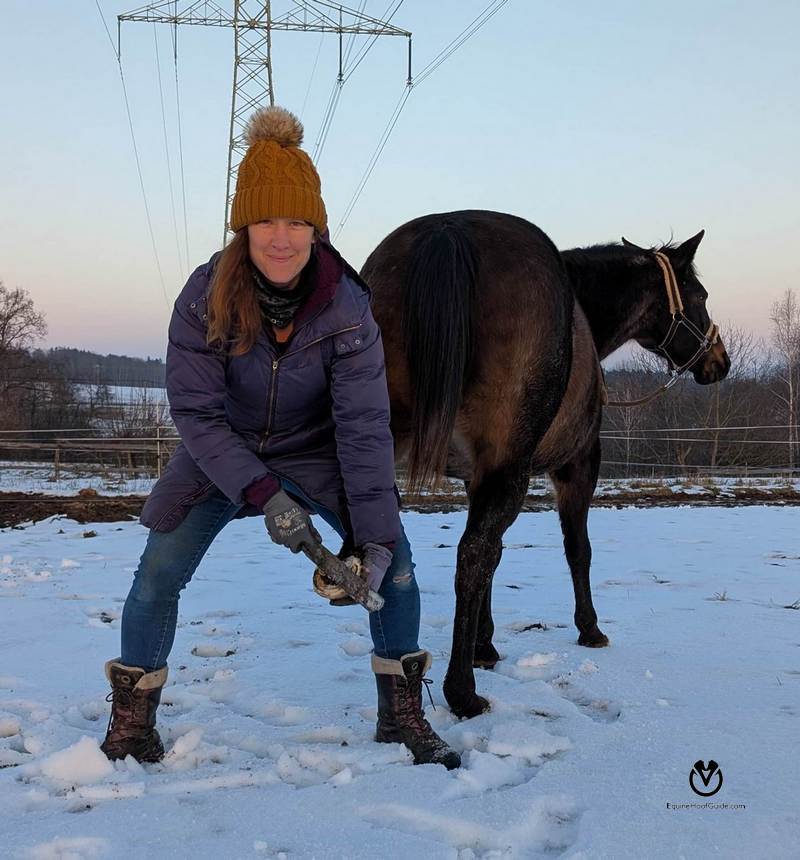
This website is the English equivalent of Czech educational website www.srovnejkopyta.cz which was created for the purpose of collecting evidence and comparing the results of different methods of hoof trimming and shoeing over a longer period of time in the Czech republic, due to growing interest of horse owners and conflicting dialogues among hoofcare proffesionals. A closer examination shows that the horse’s hoof is capable of great plasticity. It is able to change (to shape or to deform) in various ways during the horse’s life, which affects the quality of its movement and overall health. In addition to the diet and the environment in which the horse lives, whether the hoof will be healthy or not can be significantly influenced by a specific hoofcare (ideally, all three areas should be balanced and complement each other).
Farriery has a rich history in the Czech Republic. It is mainly represented by using so called pasture trim and shoeing with metal shoes. These two approaches are generally accepted as a traditional method of hoofcare. In recent years, new insights from abroad have emerged regarding other approaches to trimming and protecting horse hooves. These methods often appear more suitable, as they allow hooves to maintain a physiological state, stay close to it, or aid in restoring the hoof to a physiological state if deformation has already occurred (barefoot trim inspired by hoof shape of feral horses enriched by scientific research, using boots, polyurethane shoes, shoes with polsters that support the coffin bone and allow stimulation of the sole and the frog even when the horse is shod with metal shoes etc.).
Contrary to prevailing opinion, that one cannot apply one method to every horse, many of the scientific findings and methods tested on various horses confirm the validity of certain principles that seem to be common for most hooves of different breeds of horses. Simply because the anatomy is same in every horse and because same laws of physics apply to every horse and hoof. In many cases, applying these principles has proven effective in correcting even severely deformed and diseased hooves, including those affected by severe laminitis, all without the need for metal shoes. We can see from sufficient number of case studies that long-term and incorrect shoeing (or incorrect farrier pasture trim) done within too long intervals can directly cause most unwanted deformations. By simple adjustments in certain principles, the hoof can be prevented from such deformations or return to its physiological state, become stronger and able to move even on stony and hard surfaces, without serious consequences as the horse gets older. It is therefore worth examining these new perspectives about horse hooves, to see to what extent they are applicable in practice and possibly to re-evaluate traditional trends.
The accumulated evidence should serve horse owners well in making decisions and choosing the appropriate method (functional principles) of hoof trimming and shoeing. It should be noted that understanding the principles of functioning of healthy hooves and their adjustments requires a certain amount of time of studying. Aditionaly to my articles, I invite the reader to visit the section Information hub, which will include useful links and recommended publications of other hoof care professionals.
It is very likely that there may be several functional methods of trimming and protecting horse’s hooves, depending on the use of the horse, and it is important to monitor the results of these methods in the long term, compare them and further improve them if they ask for it, for the benefit of the horses. Its very likely that all these functional methods share common principles and do not contradict each other simply because they are compiled with respect to the anatomy and physiology of the horses hoof and its purpose.
Šárka Prokůpková (horse owner, former barefoot trimmer, amateur researcher)
Please note that the aim of this website is not to determine whether barefoot or shod is superior, as both have their positives and negatives based on the horses past husbandry practices and use, and serious hoof deformities can occur in either case if the approach to hoof care is not optimal. Instead, the website focuses on presenting specific facts, details, and comparisons to provide a clearer understanding of the hoof and the root causes of hoof deformities in general, with the goal of preventing such deformities in both barefoot and shod horses.
